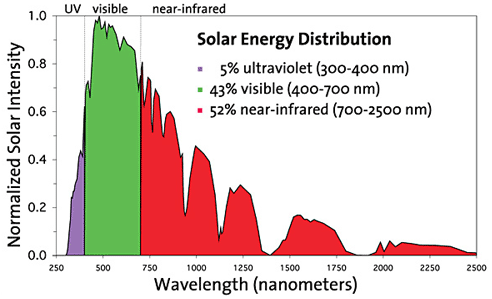The sun produces an unbelievable amount of energy that reaches the earth. The amount of energy that is absorbed by the earth in one hour is more energy than mankind uses in one year.
Solar Energy Systems
The total amount of solar energy reaching the earth in one year is huge – twice as much energy as ever existed from all sources of coal, oil, natural gas, and uranium combined. The sun strikes the surface of the earth at different angles ranging from 0 degrees (no sun) at the poles to 90 degrees at the equator during spring and fall.
At the equator during noon time, the earth’s surface gets the maximum amount of energy. As one moves away from the equator, the sun’s rays have to travel longer through the atmosphere. Along the way some rays are reflected into space or scattered by clouds causing loss of energy as they go, on average, about 50% of the sun’s energy makes it through the atmosphere and strikes the earth.
The tilt in the earth’s axis of rotation also causes variations in the amount of sunshine received, the North Pole receives little sunshine in the winter months and likewise the South Pole receives little in the summer months. So the amount of solar energy that reaches any given location varies by latitude, time of year, time of day, and local weather.
There are two techniques to converting solar energy into electricity, the thermal technique and the Photovoltaic technique (PV).The first technique works on thermal energy generation from sun by concentrates the sunlight to create heat in fluid, and that heat is used to run a heat engine, which turns a generator to make electricity.
The working fluid that is heated by the concentrated sunlight can be a liquid or a gas. Different working fluids include water, oil, salts, air, nitrogen, helium, etc.
Different engine types include steam engines, gas turbines, Stirling engines, etc. All of these engines can be quite efficient, often between 30% and 40%, and are capable of producing 10’s to 100’s of megawatts of power.
Heat storage which is what makes solar thermal so attractive for large-scale energy production, where the heat can be stored during the day and then converted into electricity at night solar thermal plants that have storage capacities can drastically improve both the economics and the dispatchability of solar electricity.
Photovoltaic (PV) solar technology or photovoltaic panels convert sunlight directly into electricity this technology has undergone many stages of development both at the level of solar cells and the level of PV solar systems to improve efficiency and reduce cost.
Advantages of Solar PV
- Solar energy is free energy!
- PV operates even in cloudy weather conditions
- Modular custom-made energy that can be sized for any application such as Power plants, Houses, satellite, Space ship, cars, sea vessels and aircraft.
- Operating and maintenance costs for Photovoltaic panels are considered to be low, almost negligible, compared to costs of other renewable energy systems
- Photovoltaic cells are totally silent and have no mechanically moving parts – they are a perfect solution for residential areas
- Solar PV is environmentally friendly, as when solar panels generate electricity there are no emissions emitted
- Solar panels are a highly promising future both for economic viability and environmental sustainability
- Solar energy can be made available almost anywhere there is sunlight
The solar spectrum energy
The energy in solar radiation comes in the form of electromagnetic waves of a wide spectrum. Longer wavelengths have less energy than shorter ones, the solar spectrum divides into three types of radiation, Infrared (IR), visible light and ultraviolet (UV), See the graph.

Intensity and Energy
For the purpose of solar power, the most significant measures are the intensity and energy delivered – one measure at a point in time, the other over a period of time.
At a point in time
Irradiance [W/m2]: The intensity of solar radiation hitting a surface, which is the sum of the contributions of all wavelengths within the spectrum, expressed in units of Watts per m2 of a surface, for example 1000 watts per square meter.
Over a period of Time
Energy per unit area [kWh/m2]: Energy per unit area is a measure of irradiance incident on a surface over a period of time, for example 1000 kilowatt per square meter per Hour.
Related Posts
- Solar Energy Systems
- Solar Cell | Photovoltaic Cell
- Solar Concentrator PV Systems
- 3D Solar Cells
- 3D Solar Cell Systems
- Electrical Specifications of PV Modules
- Standard Test Conditions for PV Modules
- PV Arry Charge Controllers
- Sizing a Grid-Direct PV System
- Sizing a Battery-Based PV System
- Site Survey for PV Installation
- Understanding Solar Radiation for PV Installlation
- Concentrating Solar Collectors
- Solar Energy Systems
- Solar Panel Working Principle